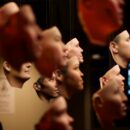The first tissue problem—or why you should eat your own dog food

You reach for a tissue from a brand-new box, expecting a smooth, elegant pull. Instead, nothing budges. That first tissue is glued to the second like a child clinging to its mother’s leg on the first day of school. You poke, you pinch, you wiggle a corner free. Which then rips off in your hand. Eventually, you just shove your fingers inside the box like a burglar prying open a safe, and the whole top layer of tissues comes out in one ragged, unusable clump. Which will never go back into the box.
Eventually, after some unnecessary struggle, the tissues start flowing normally. But that first one? That one was sent to whiten your hair.
This is not a minor inconvenience. It is a window into the world of product design — and more importantly, into the glaring disconnect between the people who create products and the people who use them. This small, maddening irritation is more than just an issue of bad box design. It’s a metaphor for something much bigger—the way big companies, especially the ones run by layers of senior executives, seem to specialize in not testing their own products.
Now, tell me, why is this still happening? We’ve put rovers on Mars, built self-driving cars, and trained AI to write passable poetry. Yet, after decades of manufacturing tissues, hardly anyone has figured out how to make the first one come out without a fight?
Have the senior executives of the tissue company never, ever opened one of their own boxes themselves? They are probably far too important to fuss with tissues. They have assistants, house staff, hotel rooms where everything is magically pre-opened for them. They sign off on packaging designs in boardrooms, nod sagely at market research reports, and discuss customer touchpoints in strategy meetings. But it seems they have never actually tried to extract that cursed first tissue with their own fingers.
If they did, the design would have changed years ago.
This isn’t just about tissues, of course. You get an enthusiastic, well-designed message telling you about a groundbreaking new feature, a seamless customer experience, a one-click registration. You click the link. It’s broken. You refresh, you try a different browser, you check if it’s your internet. Nope. The link just doesn’t work. The geniuses who wrote the email never clicked on it before sending it to every customer.
Or consider the new self-service portal rolled out with great fanfare. You’re told it’s “intuitive,” “effortless,” and “built with you in mind.” But the moment you try to log in, it demands an account you didn’t know you needed, sends a verification email to an address you haven’t used since 2013, and offers a password reset process that makes you question the meaning of your life.
Meanwhile, the executives behind this catastrophe are in a boardroom, watching a PowerPoint slide that says “99% uptime” in bold font. None of them has tried to log in themselves. They assume it works because someone in a meeting said it does. And that’s enough for them. If senior executives at software companies had to use their own customer portals, they would discover that most “customer journeys” are actually obstacle courses.
This is what happens when people don’t eat their own dog food. That’s the tech-world phrase for using the thing you sell, testing it like a real customer. Steve Jobs was obsessed with the unboxing experience of Apple products because he knew that the first interaction is everything. Jeff Bezos made Amazon executives spend time in customer service, answering real queries, because you can’t fix what you don’t experience firsthand.
The irony is, the solution is so simple. Just try your own stuff.
But they don’t. They are too far removed, too insulated. The higher you climb in an organization, the less contact you have with the reality of what you sell. You spend more time in meetings about the product than with the product itself. You talk more about the user than being the user.
This isn’t just bad for customers; it’s bad for business. Products and services improve dramatically when their creators actually experience them. When engineers fly economy, plane seats improve. When bank CEOs try opening accounts online, apps get simpler. When senior leaders are forced to call their own call centres, wait times shorten.
Imagine if the CEO of a tissue company had to rely solely on their own tissues during flu season — no assistants, no pre-opened boxes, just them, their sniffles, and that first stubborn tissue. I promise you, by the end of that week, there would be a cross-functional task force and a six-month project to redesign the opening mechanism.
The fundamental truth is this: distance breeds complacency. Proximity breeds care. The closer you are to the actual experience of your customer, the more likely you are to care about fixing the small but infuriating things. The further away you get, the easier it is to convince yourself that everything is fine.
(Sunday Nation, 23 March 2025)

Buy Sunny Bindra's new book
The X in CX
here »
Popular Posts
- You are who you hang out withSeptember 28, 2025
- The cost of pretenceSeptember 7, 2025
- Born knowing the waySeptember 21, 2025
- The art of the CX rescueSeptember 14, 2025
- Bruise, mend, continueAugust 31, 2025











